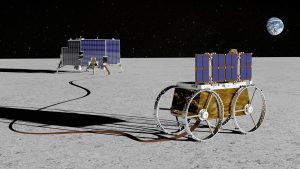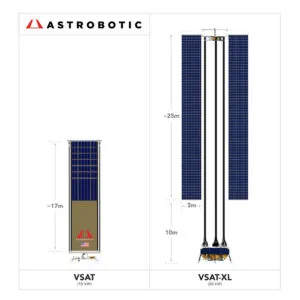Standing at 30m tall, they will have the ability to generate 50kW of power from the dual 20-meter-long solar panels.
Astrobotic highlights that VSAT-XL would be the largest planned lunar power infrastructure to date. The plan is to meet the growing power requirements of planned lunar missions and provide energy to a range of lunar surface assets
“As lunar surface missions continue to grow in scale and scope, the ability to generate, store, and distribute large amounts of power will become critical,” said company CEO John Thornton.
“A system like VSAT-XL has the power capacity to support in-situ resource utilization infrastructure and long-term habitats, which could unlock a whole new class of science and exploration missions that would not be possible before.”
For comparison, Astrobotic’s existing 10 single-panel VSAT could generate 10kW.
The commercial value of the contract has not been revealed.
The system is self-levelling and tracks the sun for optimal energy capture.
According to the company, it generates power with a set of deployable/retractable solar array blankets raised over 10 meters above the lunar terrain.
Apparently this is ideal for placement at the lunar south pole where the sun circles the horizon at a low angle all year round.
The technology is will mount on top of Astrobotic’s Griffin lander.
LunaGrid
Like the smaller VSAT, VSAT-XL will be a component of Astrobotic’s LunaGrid system. This is the company’s power generation and distribution service for long-term human and robotic operations at the lunar south pole.
The idea is to supply sustained lunar surface power for a range of missions, whether lasting months or years. This will support deliveries from commercial landers and large-scale science expeditions.
 Long-duration human exploration efforts will be requiring a significant energy infrastructure, highlights Astrobotic.
Long-duration human exploration efforts will be requiring a significant energy infrastructure, highlights Astrobotic.
Right, is an impression of LunaGrid-Lite.
Prototype maturing?
Following the award Astrobotic will manufacture a prototype to test the solar array deployment system.
“Phase one was focused on finding a stable and practical design for such a colossal system and packaging it all to fit on a current-generation launch vehicle,” added Lauren Whitehouse, senior structures engineer for the company.
“Now we have the opportunity to mature VSAT-XL’s design and build and test a functional prototype. While VSAT-XL is designed to enhance operations on the Moon, its components are versatile: they can be reconfigured for use on other planetary surfaces, like Mars, or linked together to form Astrobotic’s LunaGrid power system.”
Specifically, the Nasa contract was a Small Business Innovation Research Phase II contract.
The company headquarters are in Pittsburgh, Pennsylvania.
Images: Astrobotic
See also: Nasa backs Astrobotic for Moon power generation services
FAQ
How big is the Astrobotic VSAT-XL?
It is 30m tall. The dual solar panels measure 20-meters.
Where will the technology operate?
The technology is will mount on top of Astrobotic’s Griffin lander. It will be a component of Astrobotic’s LunaGrid system.
How much power can its VSAT-XL generate?
The Astrobotic VSAT-XL will generate 50kW
How much power can its VSAT generate?
Astrobotic’s existing single-panel VSAT could generate 10kW.
What as the Nasa contract involved?
A Small Business Innovation Research Phase II contract.

